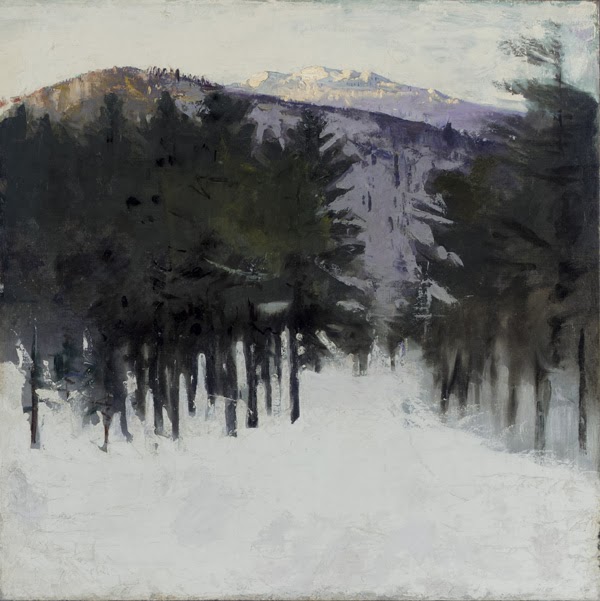 |
| Abbot Handerson Thayer, Winged Figure, 1889, The Art Institute of Chicago |
It may be the dreamer in me who is so attracted to the winged paintings of Abbott Handerson Thayer. The first of his paintings that I fell in love with was Winged Figure. above, at the Art Institute of Chicago. I’ve always admired the loose simplicity of the Grecian style of clothes, even before studying Greek art. However, what appeals most to me is the sense of security and peace this figure has as she sleeps, protected and held by the curve of her wing. Her leg and golden garment are strong and sculptural, but it’s not clear if she’s on the ground or on a cloud.
 |
| Abbott Handerson Thayer, Angel, 1887, Smithsonian American Art Museum Gift of John Gellatly Mary, the artist’s daughter, posed. |
After moving to Washington, I found that Thayer is represented well in the nation’s capital. Angel of 1887 is a very young figure, and Thayer’s daughter Mary served as the model when she was 11. She’s frontal, symmetric, quite pale and white. She may or may not be in flight. Thayer is probably the premier American painter of angels, a Fra Angelico or a Luca della Robbia in paint. He gives them an idealized beauty and paints in a pristine Neoclassical style, as well as Europeans did.
 |
| Abbott Handerson Thayer, A Winged Figure, 1904-1913, The Freer Gallery of Art, Smithsonian Institution Gift of Charles Lang Freer. The model is the artist’s daughter, Gladys |
One of the winged figures at the Smithsonian’s Freer Gallery of Art wears a laurel wreath. More rigid than his other angels, she faces us frontally with the geometry of a Greek column. Her face is severe, too, and she doesn’t quite touch the ground. Daughter Gladys was his model. (The Freer Gallery of the Smithsonian has published an explanation of the Winged Figures collected by Charles Lang Freer.)
Thayer’s preference for painting winged figures was not entirely religious. His interest in naturalism started as a 6-year old living near Keene, New Hampshire, when he began the avid study of birds and nature. However, his obsession with painting winged figures, angels and innocent children may have something to do with the fact that two of his children died unexpectedly in the early 1880s. That so many of his figures gained wings may represent hopes he had for coming to terms with loss.
 |
||||
| Abbott Handerson Thayer, Virgin, 1892-93, Freer Gallery of Art, Smithsonian Institution Gift of Charles Lang Freer (The artist’s children, Gladys, Mary, Gerald) |
 |
| Abbott Handerson Thayer, Roses, 1890, oil on canvas 22 1/4 x 31 3/8 in. Smithsonian American Art Museum, Gift of John Gellatly |
Thayer was a superb painter of other subjects. He also did portraits, landscapes and still lives, which can be found on the Smithsonian’s website. An exceptional still life at Smithsonian American Art Museum, Roses, demonstrates his incredible skill. He manages to be highly detailed with the leaves and blooms but spontaneous and expressive for the vase and background. The color is somewhat muted, but the texture is strong. The style of his still lives compares well to Edouard Manet’s textured still lives and the pristine beauty Henri Fantin-Latour’s still lives. Like the highly skilled academic painter Bouguereau, he seems to be able to combine the best of the great 19th century styles: Neoclassicism, Realism and the emotional or dreamy qualities of Romanticism.
| Abbott Handerson Thayer, Mount Monadnock, 1911, 22 3/16 x. 24 3/16 “ Corcoran Gallery of Art, Washington, DC |
The other great style of the period was Impressionism, which captured the fleeting qualities of light and colors. While Thayer may not be categorized as an Impressionist, he should be added to the list of marvelous snow painters. His best scenes of snow come from the area near where he lived in Keene and in Dublin, New Hampshire. In the Corcoran Gallery of Art’s Mount Monadnock, 1911, Thayer captured some of the beautiful scenery surrounding this mountain very familiar to him. There are vivid blues, purples and reds in this snow and the lights on the mountain top are brilliant. There’s a small, horizontal string of light coming across the ground to separate trees from mountain.
 |
| Abbott Handerson Thayer, Monadnock No. 2, 1912, Freer Gallery of Art, Smithsonian Institution. Gift of Charles Lang Freer |
 |
| Abbott Handerson Thayer, Winter Dawn on Monadnock, 1918, The Freer Gallery of Art, Smithsonian Institution Gift of Charles Lang Freer. |
 |
| Abbott Handerson Thayer, Stevenson Memorial, 1903, 81-7/16 x 16 1/8 “ Smithsonian American Art Museum, Washington, DC Gift of John Gellatly |
Thayer memorialized Stevenson, but what about his salvation? In 2008, the Smithsonian did a documentary film about him, Invisible: Abbott Thayer and the Art of Camouflage. Apparently his ideas about camouflage are more readily accepted now than they were in his time. Doesn’t his reputation as a painter deserve wide recognition, too? While keeping a foothold here on earth, his winged figures suggest that humans have the potential to transcend the hard life and fly above our limitations.

one of my favorite artist
One of my favorite art bloggers lives in New Hampshire and wrote about this painter.http://www.christophervolpe.blogspot.com/2015/04/tracking-abbott-thayers-monadnock.html